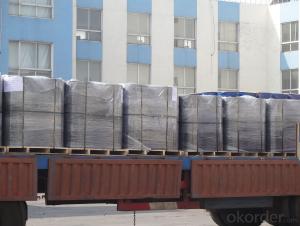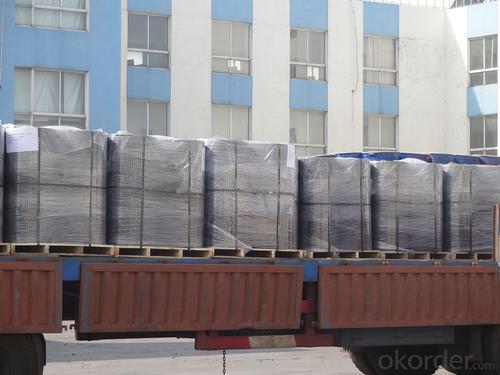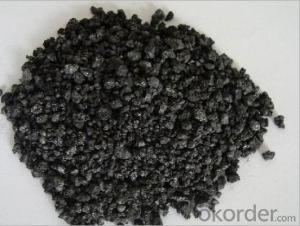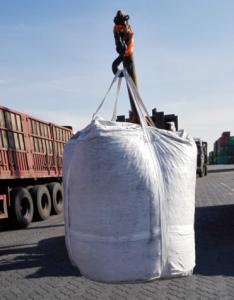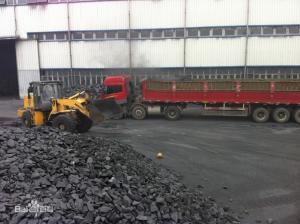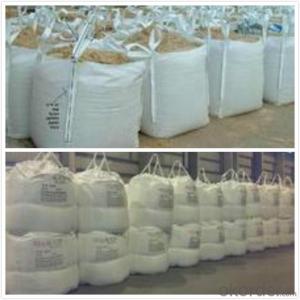Shortest Shipping Time Calcined Petroleum Coke
- Loading Port:
- Tianjin
- Payment Terms:
- TT OR LC
- Min Order Qty:
- 11 m.t.
- Supply Capability:
- 10000000 m.t./month
OKorder Service Pledge
OKorder Financial Service
You Might Also Like
1.Structure of Calcined Petroleum Coke Description
Calcined Petroleum Coke is made from raw petroleum coke,which is calcined in furnace at a high temperature(1200-1300℃).CPC/Calcined Petroleum Coke is widely used in steelmaking,castings manufacture and other metallurgical industry as a kind of recarburizer because of its high fixed carbon content,low sulfur content and high absorb rate.Besides,it is also a best kind of raw materials for producing artifical graphite(GPC/Graphitized Petroleum Coke) under the graphitizing temperature(2800℃).
2.Main Features of the Calcined Petroleum Coke
High-purity graphitized petroleum coke is made from high quality petroleum coke under a temperature of 2,500-3,500°C. As a high-purity carbon material, it has characteristics of high fixed carbon content, low sulfur, low ash, low porosity etc.It can be used as carbon raiser (Recarburizer) to produce high quality steel,cast iron and alloy.It can also be used in plastic and rubber as an additive.
3. Calcined Petroleum Coke Images
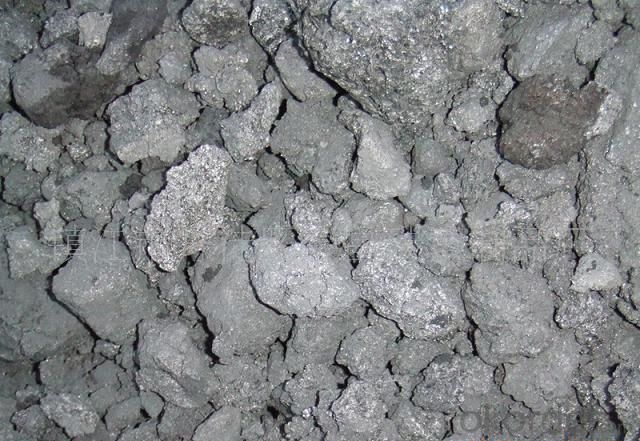
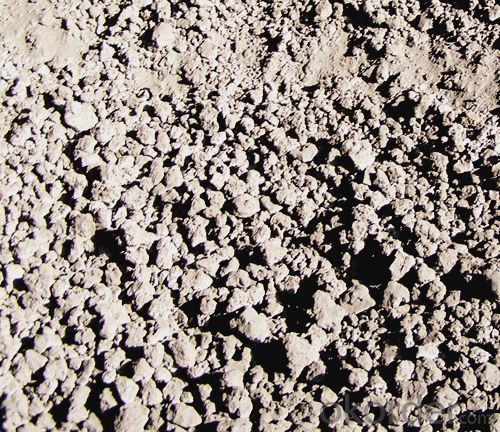
4. Calcined Petroleum Coke Specification
| Place of Origin: | Ningxia, China (Mainland) | Brand Name: | CNBM | Model Number: | 1-5MM 1-4MM 2-5MM 0-10MM |
| Application: | as carbon raiser in steel and casting factory | Dimensions: | F.C:90-96%MIN S:0.18-0.3%MAX | Chemical Composition: | F.C S ASH V.M MOISTURE |
| color: | black |
5.FAQ of Calcined Petroleum Coke
1). Q: Are you a factory or trading company?
A: We are a factory.
2). Q: Where is your factory located? How can I visit there?
A: Our factory is located in ShanXi, HeNan, China. You are warmly welcomed to visit us!
3). Q: How can I get some samples?
A: Please connect me for samples
4). Q: Can the price be cheaper?
A: Of course, you will be offered a good discount for big amount.
- Q: How does deforestation contribute to carbon dioxide levels in the atmosphere?
- Increased carbon dioxide levels in the atmosphere are significantly influenced by deforestation. Trees play a crucial role as natural carbon sinks, absorbing carbon dioxide through photosynthesis and storing it in their trunks, branches, and leaves. However, when forests are cleared or burned down for purposes like agriculture, logging, or urbanization, the stored carbon is released back into the atmosphere as carbon dioxide. The removal of trees directly diminishes the planet's ability to absorb carbon dioxide, resulting in an imbalance in the carbon cycle. Furthermore, deforestation disrupts the carbon cycle by hindering the process of photosynthesis, which is vital for converting carbon dioxide into oxygen and organic compounds. Additionally, deforestation indirectly contributes to increased carbon dioxide levels in the atmosphere through the decomposition of organic matter. When trees are cut down or burned, the stored carbon they contain is released as carbon dioxide, intensifying greenhouse gas emissions. Moreover, deforestation impacts the water cycle, leading to dryer conditions in affected areas. This causes soil to become arid, making it less suitable for plant growth and reducing the potential for carbon absorption through reforestation efforts. The cumulative effect of deforestation on carbon dioxide levels is significant. Studies indicate that deforestation accounts for approximately 10-15% of global carbon emissions, thus making it one of the leading contributors to climate change. The rise in atmospheric carbon dioxide levels, along with other greenhouse gases, contributes to the greenhouse effect, trapping heat in the atmosphere and causing global warming. To mitigate climate change and decrease carbon dioxide levels, it is crucial to address deforestation. Implementing sustainable forestry practices, promoting reforestation efforts, and protecting existing forests are essential steps in preserving carbon sinks and reducing greenhouse gas emissions.
- Q: What are the properties of activated carbon?
- Activated carbon is a highly porous material with a large surface area that allows it to adsorb or trap a wide range of organic and inorganic impurities from gases and liquids. It has a high adsorption capacity, excellent chemical stability, and is resistant to abrasion. Activated carbon is also known for its ability to remove odors, color, and taste from substances. Moreover, it can be easily regenerated and reused, making it a cost-effective and environmentally friendly solution for various purification processes.
- Q: What is the structure of a diamond, a form of carbon?
- A diamond, which is a form of carbon, has a crystal lattice structure. In this arrangement, each carbon atom is covalently bonded to four other carbon atoms, forming a tetrahedral arrangement. This creates a repeating pattern and a three-dimensional network of carbon atoms. The bonds between the carbon atoms are incredibly strong, which is why diamonds are so hard and durable. The carbon atoms in a diamond are arranged in a cubic crystal system, specifically the face-centered cubic (FCC) structure. In this system, each carbon atom is surrounded by eight neighboring carbon atoms, resulting in a dense and tightly packed structure. The strong covalent bonds and compact arrangement of carbon atoms in the diamond lattice give diamonds their unique properties. These properties include exceptional hardness, high thermal conductivity, and optical brilliance.
- Q: But their chemical symbols are different, so they are different elements, different substances, but they feel the same thing... Tangled up ~!
- No one is the same. Lead is poisonous, and pencil lead is lead. The structure of carbon is the same as that of diamonds. Generally speaking, they are of structure, density and composition. No one is the same
- Q: How can carbon capture and storage be implemented?
- Carbon capture and storage (CCS) can be implemented through a three-step process. First, carbon dioxide (CO2) is captured from industrial emissions sources such as power plants or factories. This can be done using technologies like post-combustion capture, pre-combustion capture, or oxy-fuel combustion. Second, the captured CO2 is transported via pipelines or ships to suitable storage sites. These storage sites can include deep underground geological formations, such as depleted oil and gas fields or saline aquifers. Finally, the CO2 is securely stored in these underground reservoirs, preventing it from being released into the atmosphere. Implementing CCS requires the development of appropriate infrastructure, supportive policies, and investment in research and development to make the process economically viable and environmentally sustainable.
- Q: Carbon steel with carbon steel, carbon steel yuan yuan is the same? The trouble to know the answer urgently
- For Fang Gang, bar, angle steel, steel, steel wire and other types. According to the shape of carbon structure round is carbon steel round. Especially carbon steel is often said in the past round. Such as 45# round steel. Carbon steel and carbon circle is not necessarily a variety.
- Q: I saw a cell phone in the magazine, the global release of 900, no camera, what function is F1 carbon fiber material, actually sold 40000 yuan a piece!.. Everyone said that the circulation is so small, worth so much money? Or carbon fiber material worth so much money?
- See where, in a car for example transformation kit, with super run even if the civil area shape roughly the same but the price difference, if you feel that things are expensive, natural carbon prices go up, in fact carbon species layout production process characteristics of professional strength lot, do not understand
- Q: How can we reduce carbon emissions from transportation?
- We can reduce carbon emissions from transportation by promoting the use of electric vehicles, improving public transportation infrastructure, encouraging carpooling and cycling, implementing stricter fuel efficiency standards, and investing in renewable energy sources for vehicles. Additionally, adopting more sustainable transportation policies and practices, such as telecommuting and promoting walkable communities, can significantly contribute to reducing carbon emissions.
- Q: What is carbon black rubber?
- Carbon black rubber is a type of rubber that contains carbon black as an additive. Carbon black is a finely divided form of carbon, produced by the incomplete combustion of hydrocarbon fuels. It is added to rubber compounds to improve its mechanical properties, such as tensile strength, abrasion resistance, and resilience. The carbon black particles are dispersed within the rubber matrix, providing reinforcement and enhancing its durability and performance. Carbon black rubber is commonly used in the production of tires, conveyor belts, gaskets, seals, and various automotive and industrial rubber products.
- Q: What does carbon burning mean?
- Put the burning carbon under the iron plate and make a copy of it on the iron plate, that is, carbon burning!
Send your message to us
Shortest Shipping Time Calcined Petroleum Coke
- Loading Port:
- Tianjin
- Payment Terms:
- TT OR LC
- Min Order Qty:
- 11 m.t.
- Supply Capability:
- 10000000 m.t./month
OKorder Service Pledge
OKorder Financial Service
Similar products
Hot products
Hot Searches
Related keywords

